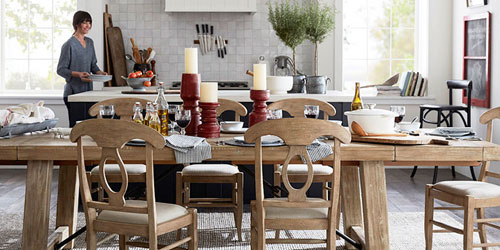How to
Care for Indoor Plants:
Indoor Plant Essentials

Indoor plants brighten up your home, freshen the air and go nicely with all types of decor. Plants are also living things that require proper care to keep them looking bright and beautiful. Many flowers and plants come with care instructions to help make it easier to keep them healthy. We at Pottery Barn have put together some tips and tricks to make caring for your plants a breeze.
Create a Schedule for Watering Plants
The main reason that plants struggle to thrive is because they receive more water than they need. However, not watering indoor plants enough can also cause problems. Salts build up in the soil when it dries out too much and leads to burned tips. Yellow leaves can indicate too much or too little water. Feel the soil with your fingers to determine its moisture level. To keep plants healthy and vibrant, set a regular watering schedule to ensure that the soil stays moist and your plants stay happy. Drainage is also important. Be sure that excess water can drain out of the bottom of the planter. Place the plant on a tray to keep your furniture protected from water damage.
Ensure Plants Have Proper Lighting
Proper sunlight for indoor plants is another critical factor. Different plants have different lighting needs, so it’s important to research the type of plant before choosing a spot for it in your home. Plants that need lots of sun should sit near a window that receives direct sunlight. If your plant likes diffused light, place it a short distance away from the window and out of the direct path of light. You could also install sheer curtains to filter the light as it comes through. If your plant’s leaves have brown spots surrounded by yellow, they are receiving too much sunlight. Move your plant to a shadier spot so it can recover.
Give Plants Extra Nutrients
Even indoor plants require frequent fertilization in order to grow and thrive. Add a blend of houseplant fertilizer to your potted plants from the months of January to September. Let them rest for the other three months. You can even find nutritious plant food in your own kitchen. For additional minerals, use soda water or cooled, leftover water from cooking once a week. Ferns, gardenias and acid-loving houseplants love a bit of cool brewed tea as well.
Help Pots Hold Water Longer
Learning how to care for indoor plants is a process that takes time. Determining how much water a plant needs and creating a watering schedule requires a little bit of trial and error. If you find that your plants require frequent watering or aren’t holding water as well as they need to, you can place a sponge at the bottom of pots and planters to help hold onto water longer. Add the soil and plant to the pot as you normally would. The sponge holds onto excess water rather than allowing it to drain out of the pot. The sponge also helps protect against overwatering because it keeps the soil from becoming overly saturated.
Repot Your Plants Regularly
As plants grow, it is important to repot them so that they have enough space. The ideal time to repot your plants is right before new growth begins, which is at the beginning of spring for most varieties. However, there are signs that can indicate your plant is overdue for a new home. Some of these signs include water running right through the pot, new leaves being smaller than normal and roots that are beginning to grow out of the bottom of the pot.
Bathe Indoor Plants on Occasion
Outdoor plants enjoy rain and the morning dew on a regular basis. This moisture gives the plants a bit more humidity and also keeps the leaves clean and shiny. Indoor plants collect dust on the surface of the leaves that can block sunlight and affect photosynthesis. Dust can also clog the plant’s pores and affect the its ability to breathe. Dusting the leaves and misting the plant with a small amount of water keeps it clean and beautiful. Take care not to mist plants that sit in direct sunlight, as this can damage their leaves.
Plants make a wonderful addition to a side table in your living room, or on your office desk. They make your home more cheerful and add to the decor of any space. We hope these tips will help you care for your indoor plants, so that they can beautify your home year after year.

